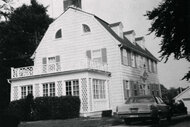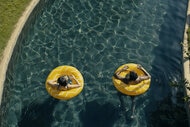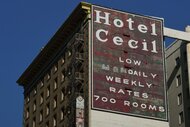Create a free profile to get unlimited access to exclusive videos, sweepstakes, and more!
'Triflers Need Not Apply': The story of deadly Belle Gunness

Making your way as an immigrant in late-19th century America was rough, even more so when you're a woman on your own. However, one such enterprising woman carved her way to fortune and infamy by employing fire, insurance fraud, and plenty of poison. This is the heinous tale of Belle Gunness, the Mistress of Murder Farms.
Her story of mayhem and murder begins in a candy shop. In 1886 Chicago, she was a young wife who ran the shop with her first husband, Mads Sorenson. Born Brynhild Paulsdatter Storset in Selbu, Norway, on November 11, 1859, she rechristened herself "Belle" when she immigrated to the U.S. at age 21. Marriage and hard work were meant to pave the way to fortune and happiness, but the couple's shop was failing. Bad luck seemed to turn to good fortune when the shop burnt down, and the Sorensons received an insurance payout sizable enough to buy a home. Then, tragedy followed.
The Sorensons had two children that died in their care. The diagnosis for both was acute colitis, a cause covered by the family's life insurance. At the time, no suspicions were raised, but as Belle developed a reputation, experts would point out that colitis has the same symptoms as poisoning: nausea, fever, diarrhea, and lower abdominal pain and cramping. In 1900, Mr. Sorenson would follow the children. Notably, he died on the one day where his two life insurance policies overlapped, giving his wife the maximum payout. As he had an enlarged heart, his doctor assumed that was the cause of death. However, the dead man's relatives accused the widow Belle Sorrenson of poisoning her husband for the insurance money. With suspicions hanging over her, Belle left Illinois behind, using the life insurance money to buy a farm on the outskirts of La Porte, Indiana.
It was in La Porte that she became Belle Gunness, marrying another Norwegian-born immigrant, Peter Gunness. This match did not last long. The couple was wed on April 1, 1902. Within a week, Peter's infant from a previous marriage would mysteriously die while in Belle's care. By December, Belle was a two-time widow. She claimed Peter had met with a fatal accident, slipping in such a way that a heavy meat grinder fell from a shelf crushing his skull. Suspicions were raised not only by the coroner but also by the gossip of the local school children. See, one of Belle's adopted children, 14-year-old Jennie Olsen, was said to have told a classmate, "My mama killed my papa. She hit him with a meat cleaver and he died. Don't tell a soul."
Jennie was brought before the coroner, where she denied this story. Then, Belle made her case to the man and somehow convinced him of her innocence. This was bad news for Jennie. While Belle told neighbors the girl had gone off to a finishing school for young ladies in Los Angeles, the grim truth would be uncovered years later on the farm's grounds.
Single once again, Belle used her farm, her charms, and her remaining children as lures to entice wealthy men to her home. She put out personal ads in newspapers across the Midwest. They read:
"Personal — comely widow who owns a large farm in one of the finest districts in La Porte County, Indiana, desires to make the acquaintance of a gentleman equally well provided, with view of joining fortunes. No replies by letter considered unless sender is willing to follow answer with personal visit. Triflers need not apply."
For many men, it seemed an offer too good to be true. Indeed it was.
Suitors began to turn up for scheduled visits to the farm. Some, like John Moe of Minnesota, brought lumps of cash to prove their worth to the widow. Strangely, Moe went missing after his visit, never to be heard from again. More suitors followed. More went missing. Meanwhile, Belle was spending her money on large wooden trunks, which one deliveryman said she was able to heft on her should as if they were "boxes of marshmallows." Neighbors began to notice Belle digging in her hog pen at night. Still, the men came, signed over deeds, handed over bank accounts, checks, and cash, then vanished into thin air.
How was Belle able to woo these men to travel so far and bestow upon her such grand gifts? A clue was left behind in a letter uncovered on her farm. To the unknowingly late Andrew Helgelien, she wrote:
"To the Dearest Friend in the World: No woman in the world is happier than I am. I know that you are now to come to me and be my own. I can tell from your letters that you are the man I want. It does not take one long to tell when to like a person, and you I like better than anyone in the world, I know. Think how we will enjoy each other's company. You, the sweetest man in the whole world. We will be all alone with each other. Can you conceive of anything nicer? I think of you constantly. When I hear your name mentioned, and this is when one of the dear children speaks of you, or I hear myself humming it with the words of an old love song, it is beautiful music to my ears. My heart beats in wild rapture for you, My Andrew, I love you. Come prepared to stay forever."
"Come prepared to stay forever." This would turn out to be a cruel joke, as the only suitor known to survive a visit with Belle would discover.
George Anderson came from Missouri to meet Belle. Over a lovely get-to-know-you dinner, she confessed her troubles in making her mortgage payments. Perhaps aiming to impress, Anderson said he'd pay off her mortgage if they decided to wed. That didn't impress Belle much. Hours later, Anderson awoke to a fright: Belle stood above him where he slept, her face lit by a sputtering candle. She was transformed, no longer warm and welcoming, her features were twisted into a countenance of hatred and disgust. When she saw that he was awake, she ran from the room. Then, he fled from the farm, a decision that saved his skin and his fortune.
Eventually, one too many men went missing. Their families wanted answers from Belle, and her sweet words would not dissuade them. Then, came the fire.
On April 28, 1908, a fire consumed the farmhouse where Belle lived with three children. Once the smoke cleared, the local authorities found the corpses of the children and the body of a woman. But in a bizarre twist, her head was missing. Nonetheless, it was presumed these were the remains of Belle Gunness, whose life of crime is believed to have begun with a fire for insurance fraud, and ended with her whole world burning down around her.
However, there was much more horror found on the farm.
A dozen men were called in to dig up the land, which was a suspected burial ground. Thousands gathered to watch what would be unearthed. There, they found what really happened to Jennie Olson as well as the bodies of two unidentified children, a slew of suitors, and more. It's estimated Gunness killed somewhere between 13 and 42 people. The horrors found under her hog pen earned her nicknames like The Lady Bluebeard and La Porte Ghoul. However, even as the bones were uncovered, there was a worry this was not the end of Belle Gunness.
She was gone, but her handyman Ray Lamphere remained. He is believed to have been her accomplice in disposing of the slain, but the two had a rocky relationship. He had hoped to woo Belle and become her partner in life and on the farm. As such, he was jealous of the suitors who swanned in like they owned the place. Months before the blaze, Belle fired him and tried to have him committed, insisting he was crazy and a threat to her and her family. When the farm burned down, he was brought in as a suspect and would ultimately be convicted of arson. Behind prison bars, he did not confess to the murder of Belle and her children. Instead, he claimed she was a serial killer and still alive.
According to Lamphere, Belle had murdered her suitors by pouring poison in their dinner coffee. While her victim was in a stupor, she'd split his skull, like she had Peter's. Then, this robust murderess would haul her victim to the basement to butcher the body. Lamphere claimed some parts were fed to the hogs, while others were buried. Then, when the heat was on her, Belle packed up the money stolen from a long line of lonely hearts, smothered her children to death, then fled for good, leaving behind a corpse that'd look enough like her to fool the authorities. He alleged the headless cadaver belonged to a woman from Chicago, who'd been promised a job as Belle's housekeeper.
Lamphere's story spread through newspapers nationwide. For years after, people would claim to have spotted Belle in Chicago, San Francisco, New York, Los Angeles, and even a small town in Mississippi up until 1931. It was as if the American public couldn't let go of this killer, who either met a hellish end on her own killing ground or escaped into anonymity to quietly swindle and kill again. Today, her story lives on a tale of a bogeywoman who valued no man nor child as much as money.
Sources: Norwegian Ridge, Murderpedia, La Porte County Historical Society Museum, The History Guy


























